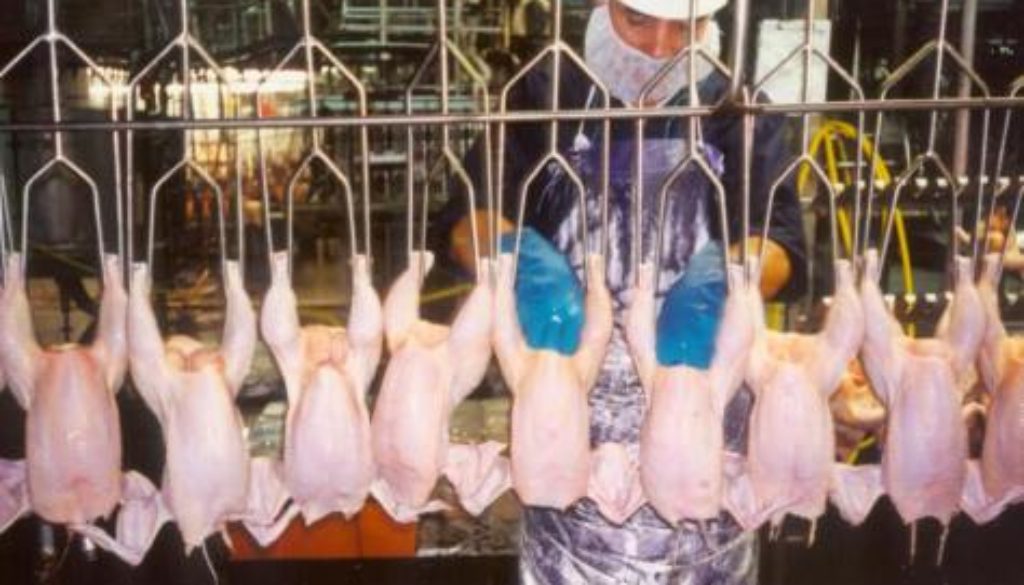Weak Labor Protections Have Put Midwestern Food Processing Workers at Risk for Coronavirus
By Colin Gordon, Hannah Halbert and Laura Dresser, Economic Policy Institute
Earlier this year, our report Race in the Heartland detailed stark and pervasive racial disparities in Midwestern states—tracing these to longstanding patterns of discrimination and segregation in the region, and the disproportionate impact of “rust belt” deindustrialization and the collapse of union membership for workers of color. Unsurprisingly, the COVID-19 crisis has magnified these disparities, and their consequences. Across the Midwest, residential and occupational segregation put African American and Hispanics in the region more at risk. And across the Midwest, public policies—by design and by neglect—do little to address or alleviate that risk.
Workers of color are disproportionately exposed at work. The luxury of working from home is steeply stratified by race and income. African American and Hispanic workers are overrepresented in low-wage direct service occupations; in the 12 states of the Midwest, for example, Hispanic workers make up 7% of the labor force but over 18%of the workforce in building and cleaning services. In Midwestern cities, African Americans are dramatically overrepresented in occupations like child care and public transit. Across the rural Midwest, workers of color make up the majority of the workforce in the concentrations of low-wage food-processing production that dot the landscape.
In all of these settings, workers face both a greater risk of unemployment as the service economy shuts down and a heightened risk of exposure if and where they keep working. These risks are exaggerated in the Midwest, where four states (Iowa, North Dakota, South Dakota, and Nebraska) are among the five nationwide that still do not have statewide “shelter at home orders.” In these states, the list of “essential businesses” is expansive and idiosyncratic, the expectation that workers show up—regardless of the risks—is clear, and the protection offered workers—by public policies or their places of employment—is virtually non-existent.
The folly, and the callousness, of these policies are on display in South Dakota and Iowa, where there have been COVID-19 outbreaks at the massive Smithfield Foods pork processing plant in Sioux Falls, South Dakota (644 cases and one death at last count) and at Tyson Foods in Columbus Junction, Iowa (186 positive tests and two deaths at last count). When Smithfield recorded its first COVID-19 case, it didn’t take sufficient action to protect their workers. It instead offered workers a “responsibility bonus” of $500 to workers who clocked in every day in April. When Tyson closed its Columbus Junction plant, they moved workers to other locations and made the decision to keep their Waterloo plant (now the site of another outbreak) open.
These are no accidents; they are profound failures of private responsibility and public policy. The choices made by Smithfield and Tyson (and by the workers who toil for them) are shaped by the paucity of meaningful labor and regulatory standards across the region.
These workers have no access to paid sick or family leave as an option. Alone among its peers, the United States has no public program of paid leave. Eleven states have state-level plans, but none of these are in the Midwest. Further, several Midwestern states (like Wisconsin, Indiana, and Michigan) have preempted municipalities from enacting their own paid leave policies. Looking at data from the Bureau of Labor Statistics, only 65% to 70%of Midwestern workers have access to paid sick leave. Some employers offer coverage, but this varies starkly by income (90% of workers in the top earnings quartile have paid sick leave, compared to just 47% of those in the bottom quartile) and by occupation. The paid leave provisions of the “Families First Act” passed in mid-March exempted private employers with more than 500 workers (Smithfield employs 3,700 in Sioux Falls; Tyson employs about 1,400 in Columbus Junction).
At the behest of Arkansas-based Tyson Foods, most Midwestern states have slashed their workers compensation systems—dramatically paring back benefits for those injured on the animal “disassembly” lines. Some states have classified COVID-19 as an occupational risk under workers compensation, but only for those exposed as “first responders.”
The Occupational Health and Safety Administration (OSHA) has suffered waves of deregulation and defunding. It now has virtually no presence on the factory floor, and received not a whisper of attention or new resources in the CARES Act. The Department of Agriculture (which also claims some regulatory authority over these plants) has acceded to new rules that allow companies like Tyson to speed up the line—putting workers more at risk, and closer together.
Without public agencies and policies on their side, these workers have also lost collective voice and representation. The meatpacking industry left Chicago and Kansas City for rural outposts like Sioux Falls and Columbus Junction in order to break union power and drive down wages. Nine of the 12 states in the region (including Iowa and South Dakota) are “right-to-work” states. In the 1970s, about half of packing workers belonged to a union; in 2019 that had fallen to just 16 percent. The loss of collective representation meant a dramatic decline in wages and, of course, the loss of bargained benefits like health-insurance.
The business model of food processing depends not just on low-wages and a light regulatory hand, but on the systematic exploitation of workers of color—many of them immigrants, some of these undocumented. These workers suffer most the absence of the basic protections offered by union representation or nominal regulation and labor standards. They are also, documented and undocumented alike, largely ineligible for means-tested safety net programs (of the 12 Midwestern states, only Wisconsin and Minnesota use state funds to extend substantial assistance to immigrants barred from receiving federal benefits). And these workers are—by occupation, region, language, and immigration status—especially vulnerable to wage theft.
In these respects, COVID-19 is the symptom and not the disease. It is not a virus that is killing Midwest workers, it is the laws and policies that—for too long—have failed to protect them.

